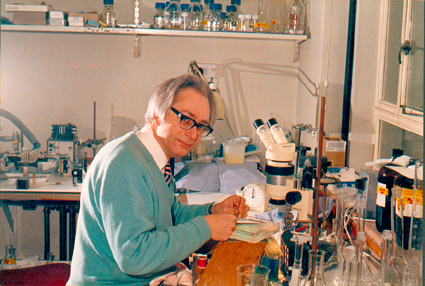The Peter F. Baker Award for young Investigator
(1939-1987)

Peter F. Baker at the Marine Biological Association at Plymouth. January 1987
Photo courtesy of Jeff Allen.
WINNER
Roger John Thompson
University of Colorado Health Sciences Center
Departments of Cellular and Structural Biology
School of Medicine, Box B111
4200 East 9th. Avenue
Denver, Colorado, USA, 80262
roger.thompson@UCHSC.edu
He died at 47 but his scientific carrier was far from short. He published his first paper when he was just 15 and continued with this labor during his undergraduate years at Emmanuel College in Cambridge. He obtained a 1st class Honor Degree in Biochemistry and the moved to the laboratory of physiology of Alan Hodking. Together with the late Trevor Shaw he introduced a new preparation of the axon of squid where its axoplasm had been extruded. This preparation provided important new insights into the mechanisms responsible for the maintaining of the electrical function of the cell like the Na+/Ca2+ exchange. He still working in squid axon at the Marine Biological Association at Plymouth until the time of his death.
In 1975 he accepted the Halliburton Professor position and became the Head of the Department of Physiology of the King's College London. There he work with several preparation to study the Ca2+ homeostasis: sea urchin eggs, barnacles, platelets, liposomes and, of course, chromaffin cells. Working with Derek Knight, he introduced the electroporation techniques to gain access to the cytosol. They established a clear relationship between intracellular Ca2+ concentration and the secretory response. They also found that this relation will be extended to a wide range of secretory cells. In 1976 he became Fellow of the Royal Society. Many of his 120 paper became classic in that many fields that he studied. We, however, prefer his "leaky cell" introduced in 1978.
However, none of these contributions
fully account for his impact on his environment either at King's College
and to our meetings he created an atmosphere of enthusiasm for science
that propagated to everybody. His early engage with science, his vocational
dedication to research and his contribution to these meetings make him
a example to be followed by those young people who want to initiate a scientist
career. In a recent letter, Mrs. Baker authorized us to use Prof. Baker
name to nominate this chromaffin research award.
- a CV
- a copy of the papers
- a letter from your supervisor
indicating the degree of participation of the candidate in these papers.
In order to facilitate the evaluation
of candidates, please use email attachments (pdf or Word files) to isccb12@ull.es